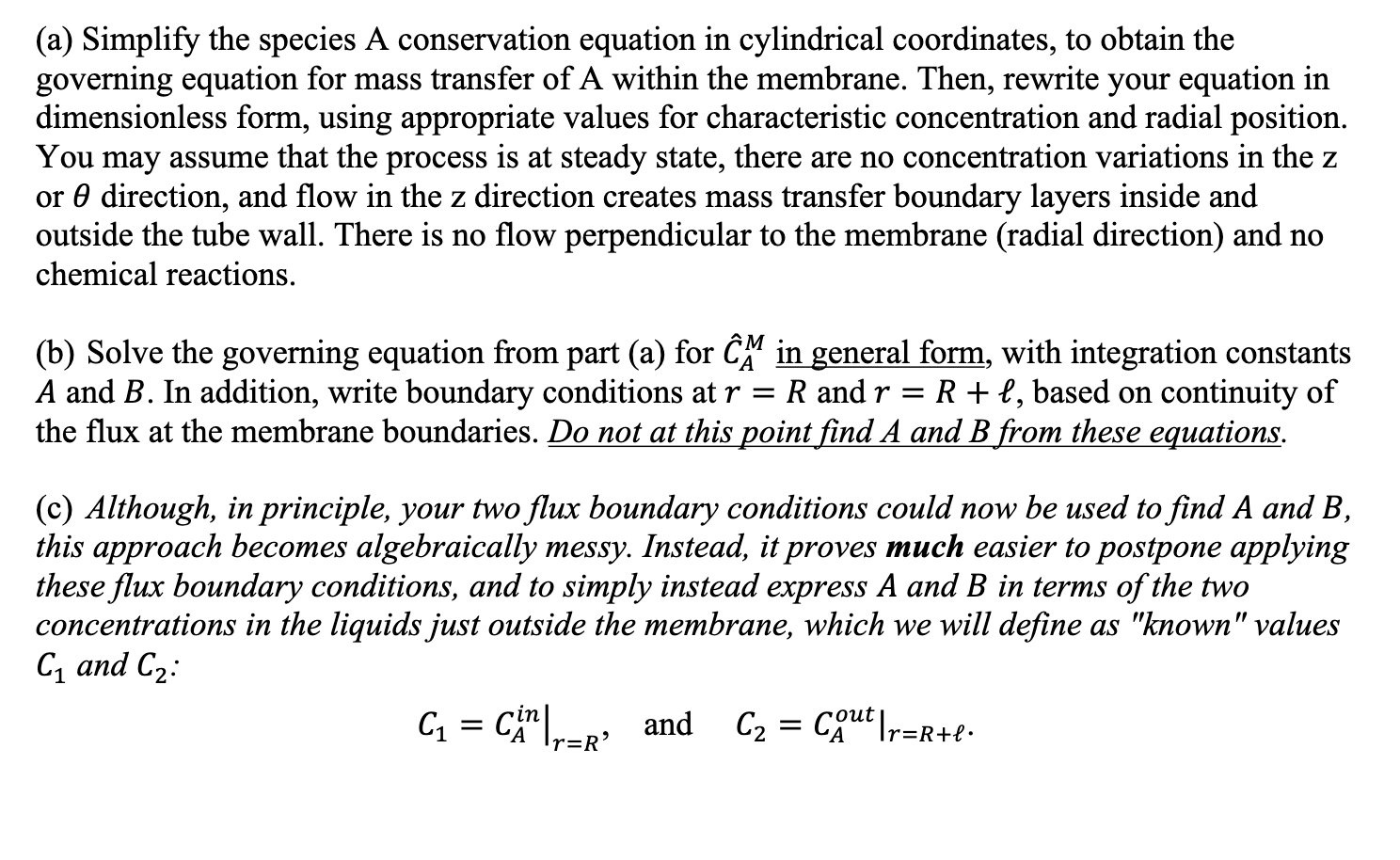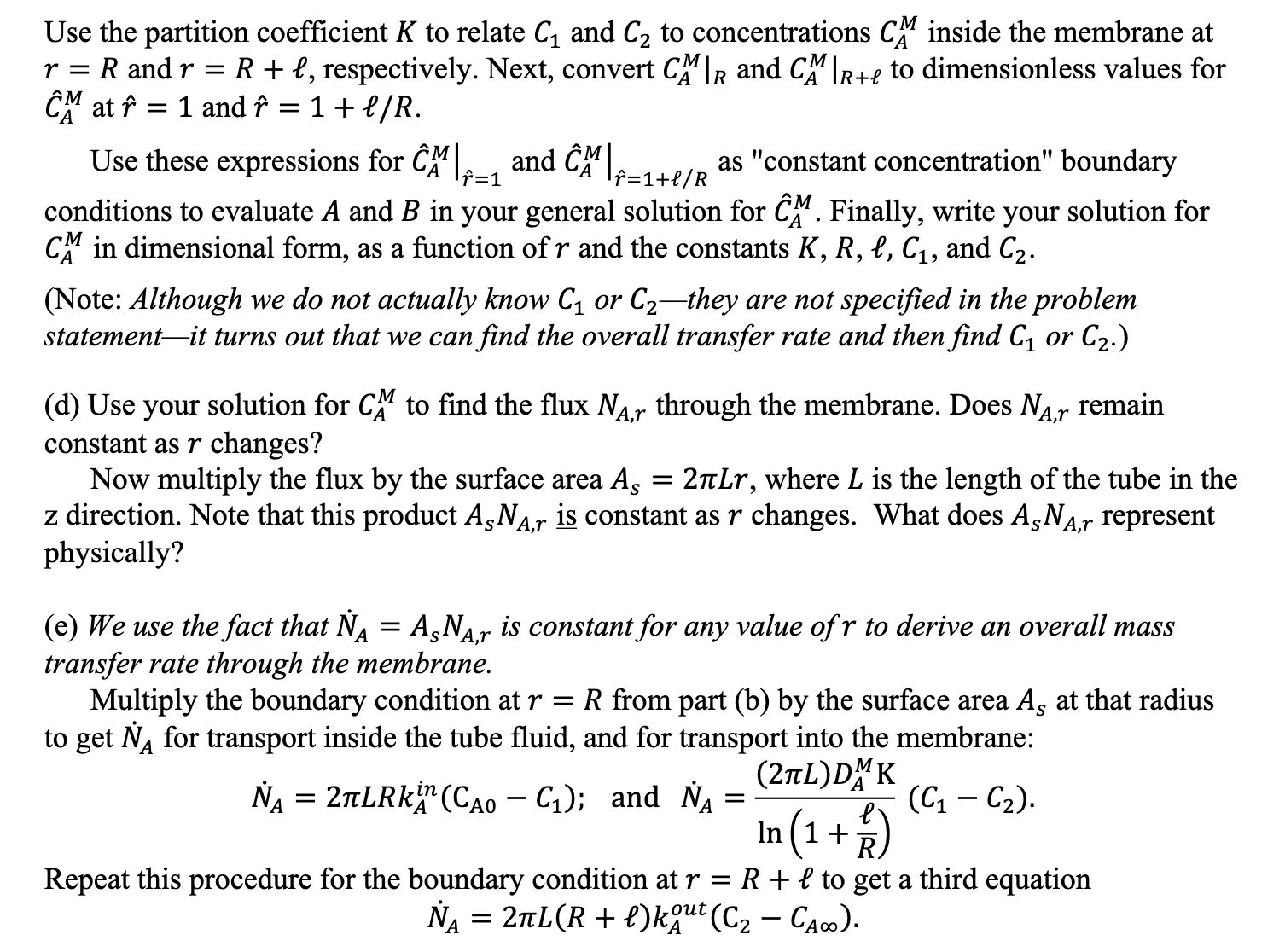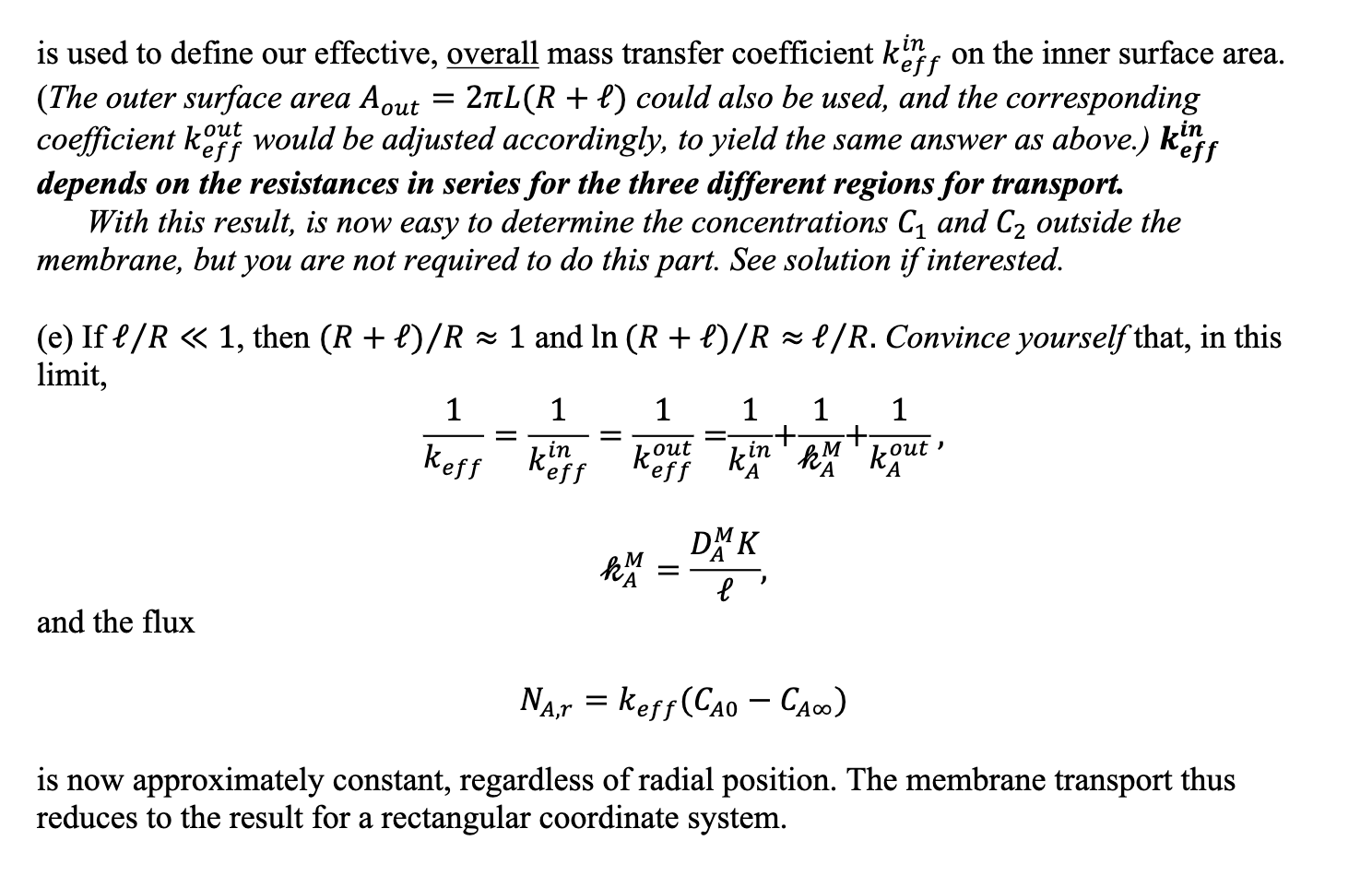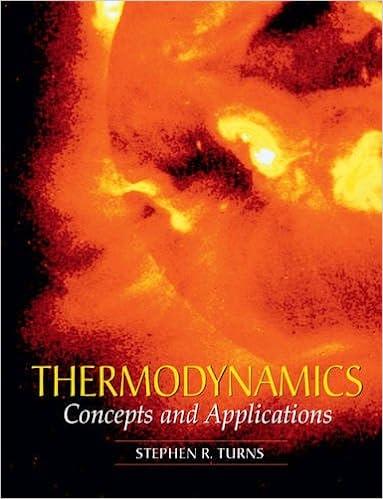Answered step by step
Verified Expert Solution
Question
1 Approved Answer
Don't copy answers from other people. Or else thumb down. 1. A hollow fiber membrane device comprises a bundle of straight, cylindrical tubes whose walls
Don't copy answers from other people. Or else thumb down.




 1. A hollow fiber membrane device comprises a bundle of straight, cylindrical tubes whose walls are membranes. An aqueous mixture from a bioreactor flows through the center of the tube, to separate the peptide product (solute A) from cells which cannot pass through the membrane. Solute A is then collected in the aqueous permeate outside the tubes. Solute A diffuses through the membrane according to diffusivity DAM. Inside and outside the tube, mass transfer boundary layers, of thickness Min and Mout, exist due to flow in the z direction. At equilibrium, solute A distributes between the membrane and aqueous solution according to the partition coefficient K=CAM/CAaq, where here CAaq represents the molar concentration in either regions inside or outside the tube. In this problem we will analyze solute diffusion through the hollow fiber membrane. Below is a diagram illustrating the problem. The membrane is found between r=R (the inner radius of the tube), and r=R+, where is the membrane thickness. (a) Simplify the species A conservation equation in cylindrical coordinates, to obtain the governing equation for mass transfer of A within the membrane. Then, rewrite your equation in dimensionless form, using appropriate values for characteristic concentration and radial position. You may assume that the process is at steady state, there are no concentration variations in the z or direction, and flow in the z direction creates mass transfer boundary layers inside and outside the tube wall. There is no flow perpendicular to the membrane (radial direction) and no chemical reactions. (b) Solve the governing equation from part (a) for C^AM in general form, with integration constants A and B. In addition, write boundary conditions at r=R and r=R+, based on continuity of the flux at the membrane boundaries. Do not at this point find A and B from these equations. (c) Although, in principle, your two flux boundary conditions could now be used to find A and B, this approach becomes algebraically messy. Instead, it proves much easier to postpone applying these flux boundary conditions, and to simply instead express A and B in terms of the two concentrations in the liquids just outside the membrane, which we will define as "known" values C1 and C2 : C1=CAinr=R,andC2=CAoutr=R+. Use the partition coefficient K to relate C1 and C2 to concentrations CAM inside the membrane at r=R and r=R+, respectively. Next, convert CAMR and CAMR+ to dimensionless values for C^AM at r^=1 and r^=1+/R. Use these expressions for C^AMr^=1 and C^AMr^=1+/R as "constant concentration" boundary conditions to evaluate A and B in your general solution for C^AM. Finally, write your solution for CAM in dimensional form, as a function of r and the constants K,R,,C1, and C2. (Note: Although we do not actually know C1 or C2-they are not specified in the problem statement-it turns out that we can find the overall transfer rate and then find C1 or C2.) (d) Use your solution for CAM to find the flux NA,r through the membrane. Does NA,r remain constant as r changes? Now multiply the flux by the surface area AS=2Lr, where L is the length of the tube in the z direction. Note that this product AsNA,r is constant as r changes. What does ASNA,r represent physically? (e) We use the fact that NA=ASNA,r is constant for any value of r to derive an overall mass transfer rate through the membrane. Multiply the boundary condition at r=R from part (b) by the surface area AS at that radius to get NA for transport inside the tube fluid, and for transport into the membrane: NA=2LRkAin(CA0C1);andNA=ln(1+R)(2L)DAMK(C1C2). Repeat this procedure for the boundary condition at r=R+ to get a third equation NA=2L(R+)kAout(C2CA) Next, divide NA for all three of these equations by the inner surface area Ain at r=R, to get three equations for NA/(2LR). One of these equations can be written more compactly by defining a membrane transfer coefficient kAM=Rln(1+R)DAMK Each of these equations for NA/(2LR) is proportional to a concentration difference. Divide each equation by the constants in front of the concentration difference, then add the resulting three equations together, canceling concentrations on the right side as appropriate. You should obtain from this a result for the overall membrane transport: NA=Ainkeffin(CA0CA) where keffin1=kAin1+kAM1+(R+)kAoutR. Here, Ain=2LR is used to define our effective, overall mass transfer coefficient keffin on the inner surface area. (The outer surface area Aout=2L(R+ ) could also be used, and the corresponding coefficient keffout would be adjusted accordingly, to yield the same answer as above.) keffin depends on the resistances in series for the three different regions for transport. With this result, is now easy to determine the concentrations C1 and C2 outside the membrane, but you are not required to do this part. See solution if interested. (e) If /R1, then (R+)/R1 and ln(R+)/R/R. Convince yourself that, in this limit, keff1=keffin1=keffout1=kAin1+kAM1+kAout1,kAM=DAMK, and the flux NA,r=keff(CA0CA) is now approximately constant, regardless of radial position. The membrane transport thus reduces to the result for a rectangular coordinate system
1. A hollow fiber membrane device comprises a bundle of straight, cylindrical tubes whose walls are membranes. An aqueous mixture from a bioreactor flows through the center of the tube, to separate the peptide product (solute A) from cells which cannot pass through the membrane. Solute A is then collected in the aqueous permeate outside the tubes. Solute A diffuses through the membrane according to diffusivity DAM. Inside and outside the tube, mass transfer boundary layers, of thickness Min and Mout, exist due to flow in the z direction. At equilibrium, solute A distributes between the membrane and aqueous solution according to the partition coefficient K=CAM/CAaq, where here CAaq represents the molar concentration in either regions inside or outside the tube. In this problem we will analyze solute diffusion through the hollow fiber membrane. Below is a diagram illustrating the problem. The membrane is found between r=R (the inner radius of the tube), and r=R+, where is the membrane thickness. (a) Simplify the species A conservation equation in cylindrical coordinates, to obtain the governing equation for mass transfer of A within the membrane. Then, rewrite your equation in dimensionless form, using appropriate values for characteristic concentration and radial position. You may assume that the process is at steady state, there are no concentration variations in the z or direction, and flow in the z direction creates mass transfer boundary layers inside and outside the tube wall. There is no flow perpendicular to the membrane (radial direction) and no chemical reactions. (b) Solve the governing equation from part (a) for C^AM in general form, with integration constants A and B. In addition, write boundary conditions at r=R and r=R+, based on continuity of the flux at the membrane boundaries. Do not at this point find A and B from these equations. (c) Although, in principle, your two flux boundary conditions could now be used to find A and B, this approach becomes algebraically messy. Instead, it proves much easier to postpone applying these flux boundary conditions, and to simply instead express A and B in terms of the two concentrations in the liquids just outside the membrane, which we will define as "known" values C1 and C2 : C1=CAinr=R,andC2=CAoutr=R+. Use the partition coefficient K to relate C1 and C2 to concentrations CAM inside the membrane at r=R and r=R+, respectively. Next, convert CAMR and CAMR+ to dimensionless values for C^AM at r^=1 and r^=1+/R. Use these expressions for C^AMr^=1 and C^AMr^=1+/R as "constant concentration" boundary conditions to evaluate A and B in your general solution for C^AM. Finally, write your solution for CAM in dimensional form, as a function of r and the constants K,R,,C1, and C2. (Note: Although we do not actually know C1 or C2-they are not specified in the problem statement-it turns out that we can find the overall transfer rate and then find C1 or C2.) (d) Use your solution for CAM to find the flux NA,r through the membrane. Does NA,r remain constant as r changes? Now multiply the flux by the surface area AS=2Lr, where L is the length of the tube in the z direction. Note that this product AsNA,r is constant as r changes. What does ASNA,r represent physically? (e) We use the fact that NA=ASNA,r is constant for any value of r to derive an overall mass transfer rate through the membrane. Multiply the boundary condition at r=R from part (b) by the surface area AS at that radius to get NA for transport inside the tube fluid, and for transport into the membrane: NA=2LRkAin(CA0C1);andNA=ln(1+R)(2L)DAMK(C1C2). Repeat this procedure for the boundary condition at r=R+ to get a third equation NA=2L(R+)kAout(C2CA) Next, divide NA for all three of these equations by the inner surface area Ain at r=R, to get three equations for NA/(2LR). One of these equations can be written more compactly by defining a membrane transfer coefficient kAM=Rln(1+R)DAMK Each of these equations for NA/(2LR) is proportional to a concentration difference. Divide each equation by the constants in front of the concentration difference, then add the resulting three equations together, canceling concentrations on the right side as appropriate. You should obtain from this a result for the overall membrane transport: NA=Ainkeffin(CA0CA) where keffin1=kAin1+kAM1+(R+)kAoutR. Here, Ain=2LR is used to define our effective, overall mass transfer coefficient keffin on the inner surface area. (The outer surface area Aout=2L(R+ ) could also be used, and the corresponding coefficient keffout would be adjusted accordingly, to yield the same answer as above.) keffin depends on the resistances in series for the three different regions for transport. With this result, is now easy to determine the concentrations C1 and C2 outside the membrane, but you are not required to do this part. See solution if interested. (e) If /R1, then (R+)/R1 and ln(R+)/R/R. Convince yourself that, in this limit, keff1=keffin1=keffout1=kAin1+kAM1+kAout1,kAM=DAMK, and the flux NA,r=keff(CA0CA) is now approximately constant, regardless of radial position. The membrane transport thus reduces to the result for a rectangular coordinate system Step by Step Solution
There are 3 Steps involved in it
Step: 1

Get Instant Access to Expert-Tailored Solutions
See step-by-step solutions with expert insights and AI powered tools for academic success
Step: 2

Step: 3

Ace Your Homework with AI
Get the answers you need in no time with our AI-driven, step-by-step assistance
Get Started


